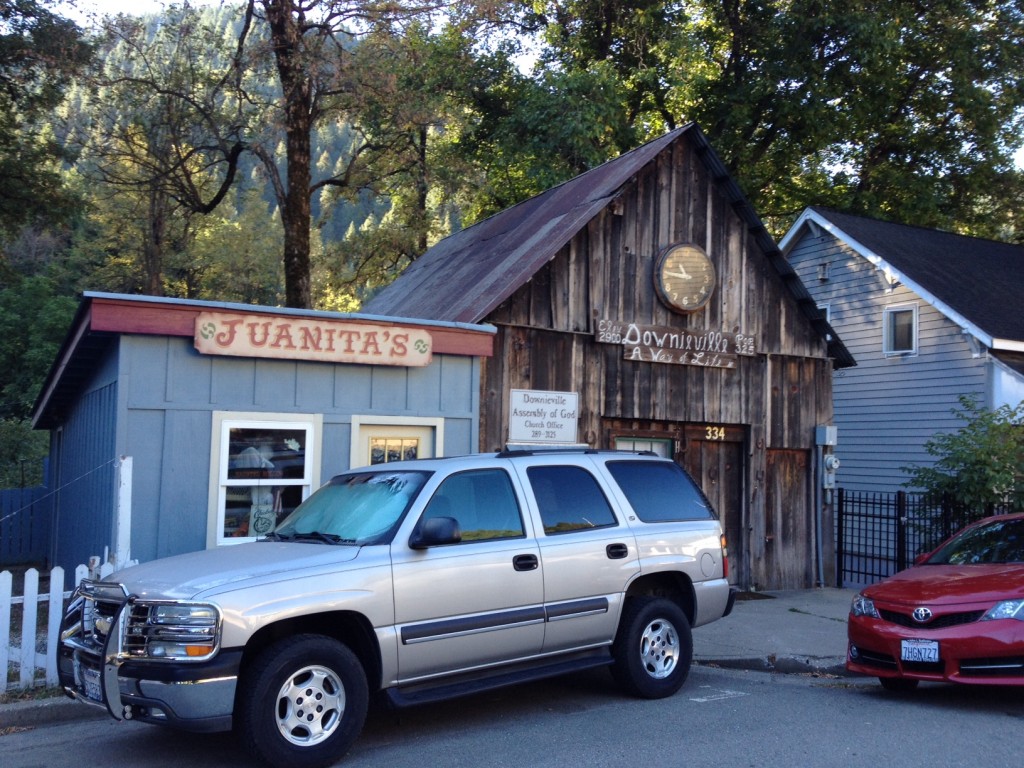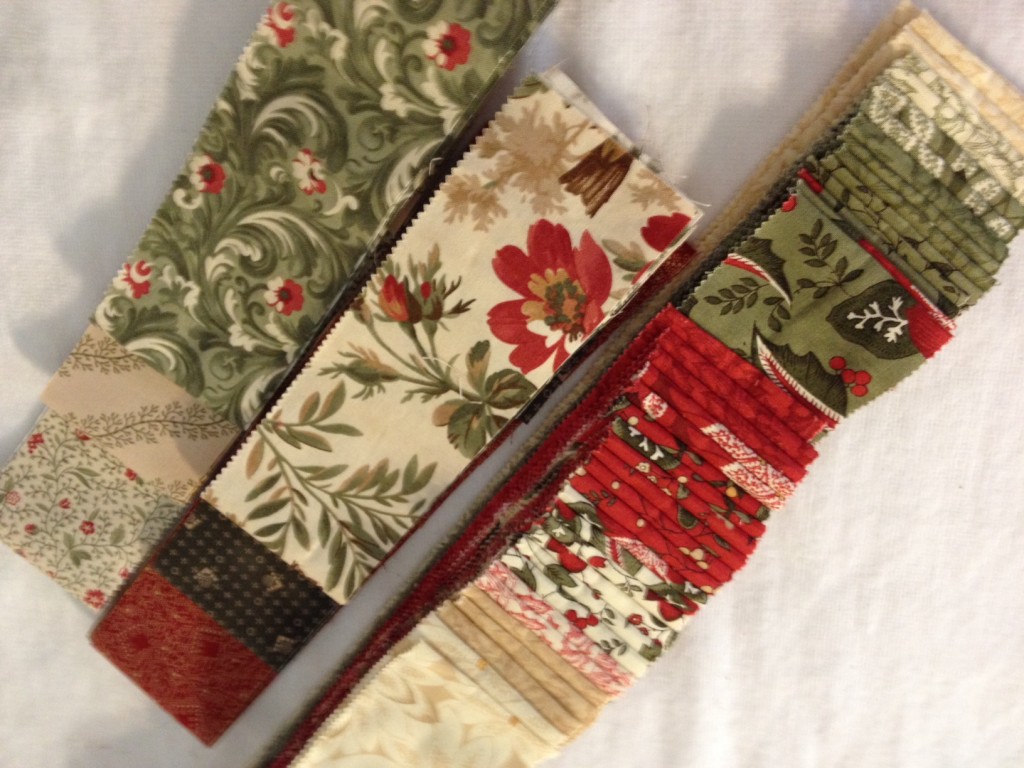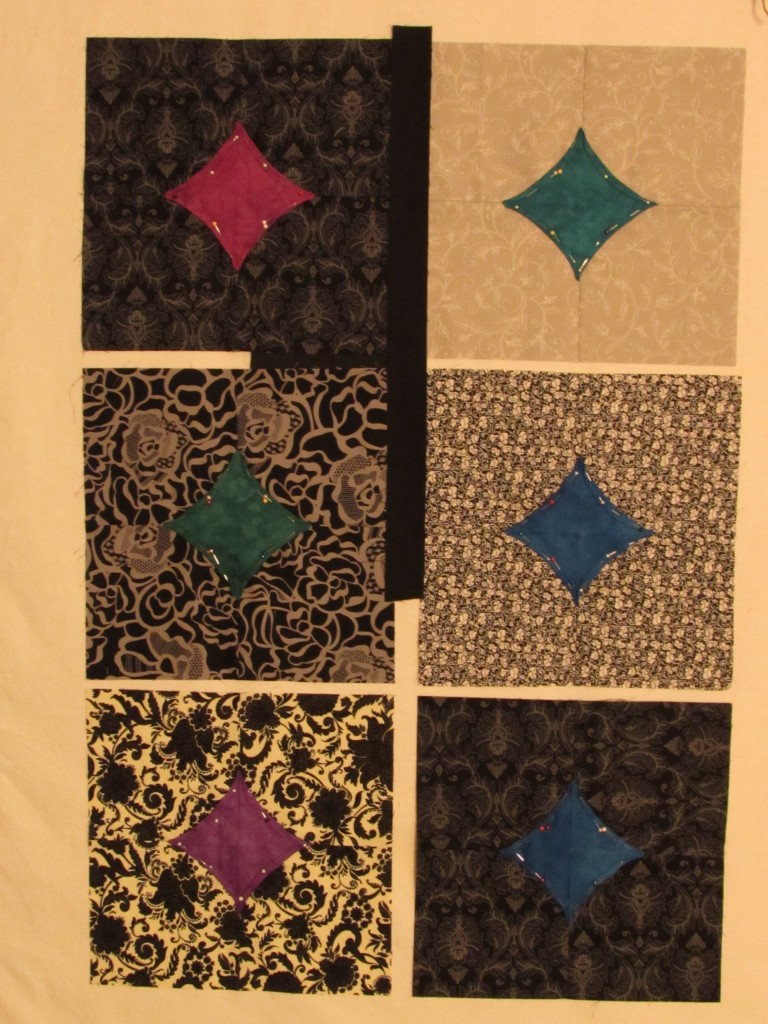Great title for a post, right??
This weekend my friend Sophia and I went to a quilt retreat that was hosted by a quilt guild in the neighboring community of Downieville. Downieville is a gold rush town that is about 50 miles from my home. Unfortunately, 30 of those miles are cutting through the Sierras on a really, really winding road. (Yuk.) It is worth the nasty drive though. Downieville is a gorgeous, tiny town of about 500 people. It sits on the north fork of the Yuba River which flows through Downieville and winds its way through the Sierras to my hometown of Grass Valley. It is a popular place for fishing, mountain bike riding, and hiking. The main block of “town” consists of three restaurants, two shops, a tiny theatre, the community center, and a hardware store. Check out the North Yuba River. I love the one bright red tree that had already turned to its fall color.
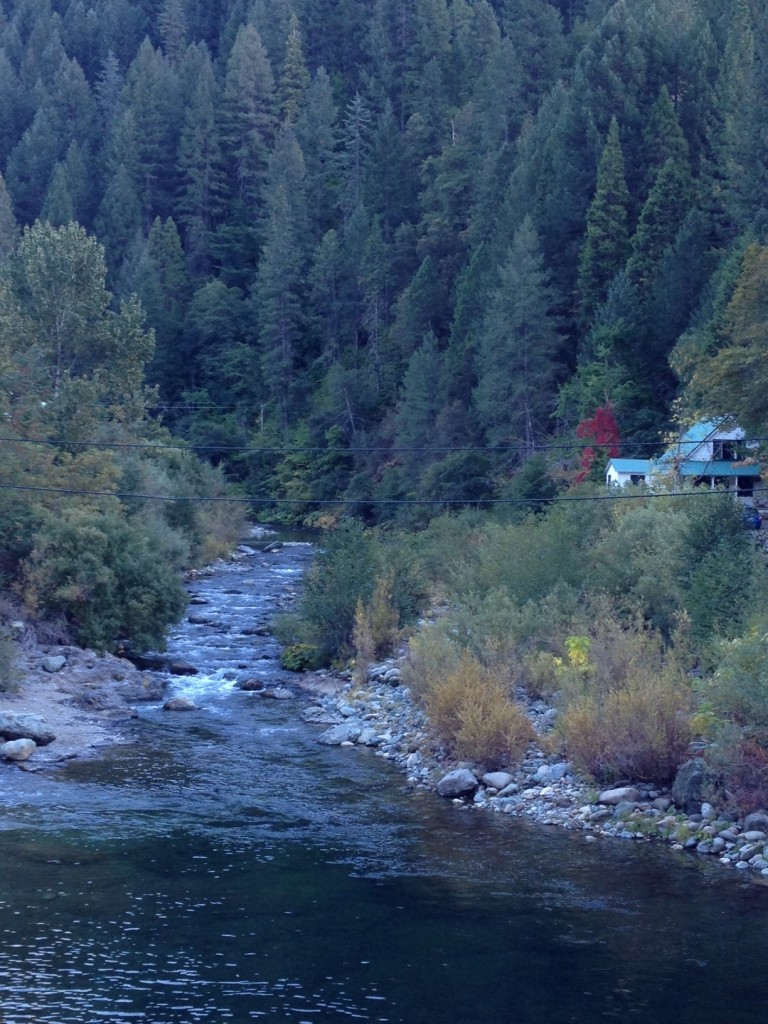
Downieville has a colorful history as a gold rush town. While we were there Sophia and I noticed that several buildings bore the name “Juanita”. This made me curious because my younger sister’s name is Juanita.
One of the “Juanita” sightings was a sign on the door between Sophia’s motel room and mine. Sophia was in room 5 and I was in room 7. On the door of room 6 was the name “Juanita”. We thought this odd since the other rooms didn’t have any names on the doors. We didn’t have any decent cell reception being in such a remote town so I figured I would google this when I got home. Clearly Juanita had some history in Downieville.
 After doing the research, I am somewhat glad I didn’t check into this until I got home! Apparently, there was a Mexican woman living with her lover (Jose?) in Downieville in the early 1850’s, which was during the height of the Gold Rush in California. This woman, Josefa Segovia, was the only woman to be lynched in the history of California. Yikes! This story is a horrid tale of the treatment of the Mexican population living in the old gold rush towns during that time period. Apparently, a gang of drunk miners, led by a guy by the name of Frederick Cannon showed up at the home of Josefa and her lover during the night. They were angry with Josepha and Jose because of an incident at a saloon earlier in the evening. Some say they attempted to gang rape Josepha. Somehow she was able to get her hands on a large knife and stabbed and killed Frederick. This was impressive since history says that Josefa was a tiny woman in her early 20’s. She was declared guilty without any trial and lynched the following day, July 5, 1851. The historical records don’t often use this woman’s true name. They call her Juanita which began as a show of disrespect, using a more familiar name rather than her true name.
After doing the research, I am somewhat glad I didn’t check into this until I got home! Apparently, there was a Mexican woman living with her lover (Jose?) in Downieville in the early 1850’s, which was during the height of the Gold Rush in California. This woman, Josefa Segovia, was the only woman to be lynched in the history of California. Yikes! This story is a horrid tale of the treatment of the Mexican population living in the old gold rush towns during that time period. Apparently, a gang of drunk miners, led by a guy by the name of Frederick Cannon showed up at the home of Josefa and her lover during the night. They were angry with Josepha and Jose because of an incident at a saloon earlier in the evening. Some say they attempted to gang rape Josepha. Somehow she was able to get her hands on a large knife and stabbed and killed Frederick. This was impressive since history says that Josefa was a tiny woman in her early 20’s. She was declared guilty without any trial and lynched the following day, July 5, 1851. The historical records don’t often use this woman’s true name. They call her Juanita which began as a show of disrespect, using a more familiar name rather than her true name.
When I was doing this bit of research, I found out that the Inn I stayed at (with the name Juanita on the door) is listed as “certified to be haunted”. Of course, it is easy to guess who haunts the place…. Juanita. Supposedly there have been proven ghost experiences in rooms 1 and 3 (kind of glad we were in rooms 5 and 7!) For the most part, I do not believe in ghosts or supernatural activity. But it might have been uncomfortable to hear all of this and then to stay in this place for the night. The motel, one of two in town, was a bit on the sketchy side.
Here is Juanita’s home.
This whole story was such a wild bit of history to discover. It made my quilt retreat weekend that much more memorable.
The weekend itself was great, even without all of the tales of ghosts and lynchings. Sophia and I were able to indulge ourselves with two long days of sewing, some good food and a nice hike. Wonderful! I completed about 85% of two different quilt tops. One of them was a strip quilt, or a 1600 quilt. If you haven’t made a 1600 quilt, it is incredibly simple. It requires a jelly roll or a set of 45-50 2 and 1/2″ strips. I used the line called “Merriment” by Moda. I also added in some strips to be able make a larger quilt.
These are sewn end to end until you have a length of fabric that runs about 1600 inches. Mine was closer to 2000 inches as I added the extra strips. Here is the first pile of strips when sewn end to end. I also cut some of my red strips into 2 and 1/2″ blocks and used them intermittently when sewing the very long strip together at the beginning. I was hoping that these little blocks would be more noticeable than they actually were. The effect would have been nicer had I used a different color, maybe a gold or a color with some shimmer to it.
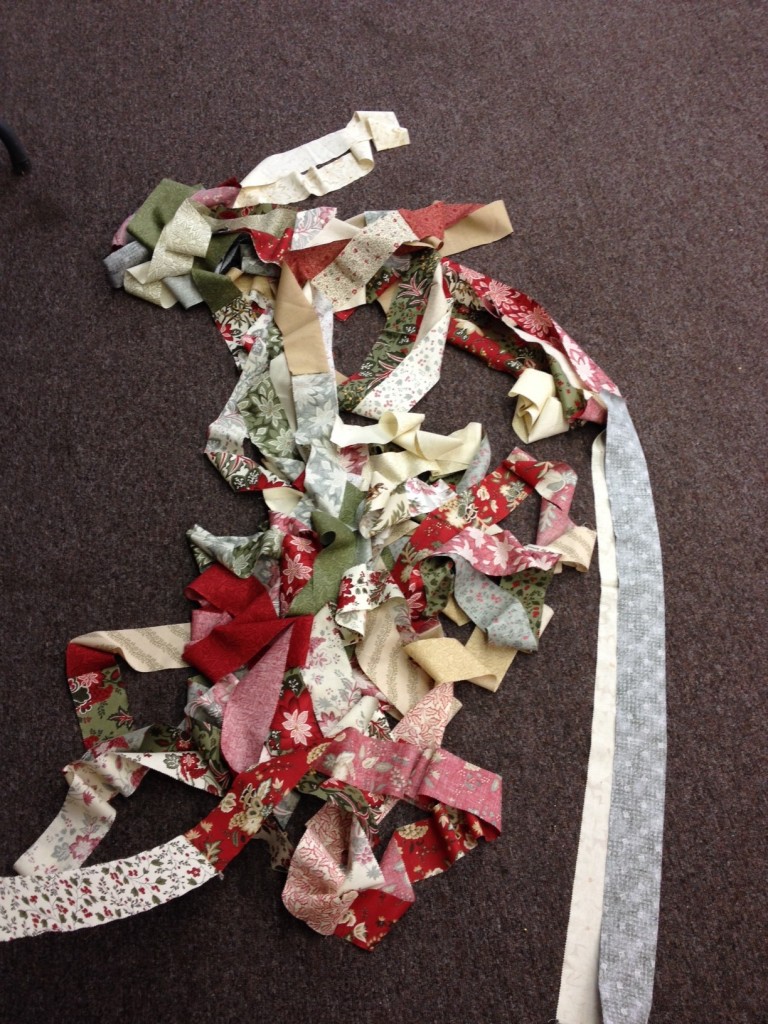 Once the strips are sewn into one length, they are folded in half and sewn together (lengthwise) so that you now have a long strip that is two rows deep. This is done again and again to create the quilt. I trimmed off five strips that were 2 and 1/2″ wide to use as an outer border. I added a 1 inch wide dark green border to the main quilt and then attached the striped border. The overall effect is lovely.
Once the strips are sewn into one length, they are folded in half and sewn together (lengthwise) so that you now have a long strip that is two rows deep. This is done again and again to create the quilt. I trimmed off five strips that were 2 and 1/2″ wide to use as an outer border. I added a 1 inch wide dark green border to the main quilt and then attached the striped border. The overall effect is lovely.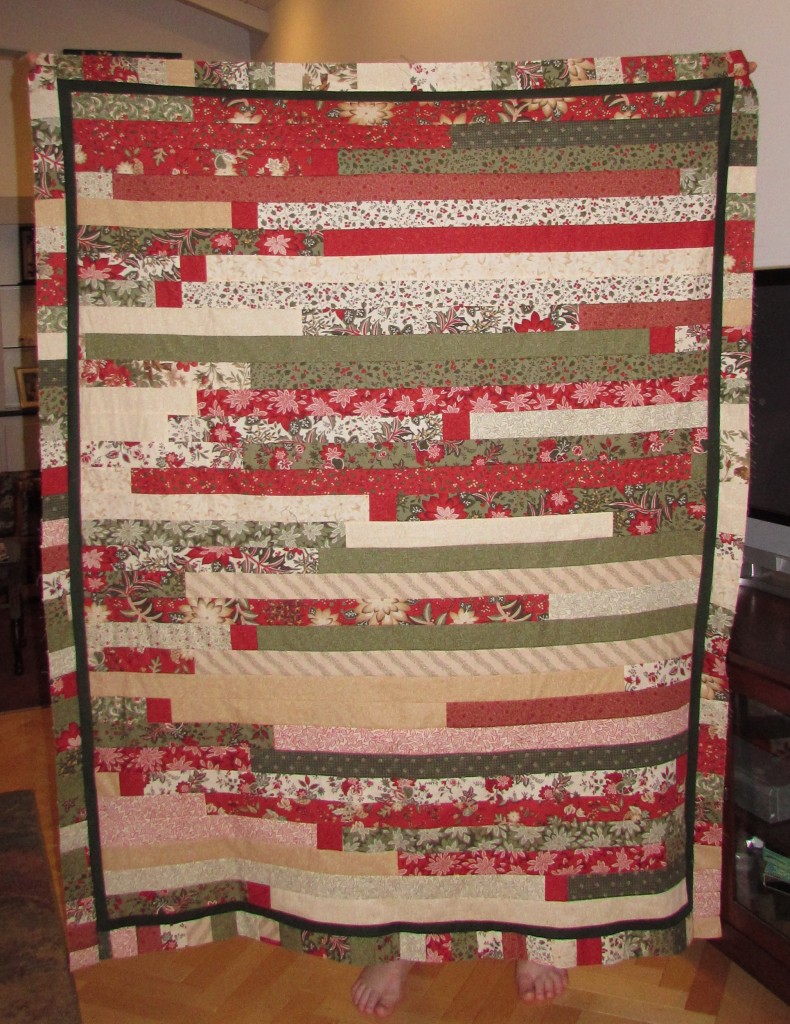 Thank you to my husband for assisting with the phot shoot, those are his toes peeking out at the bottom!
Thank you to my husband for assisting with the phot shoot, those are his toes peeking out at the bottom!

